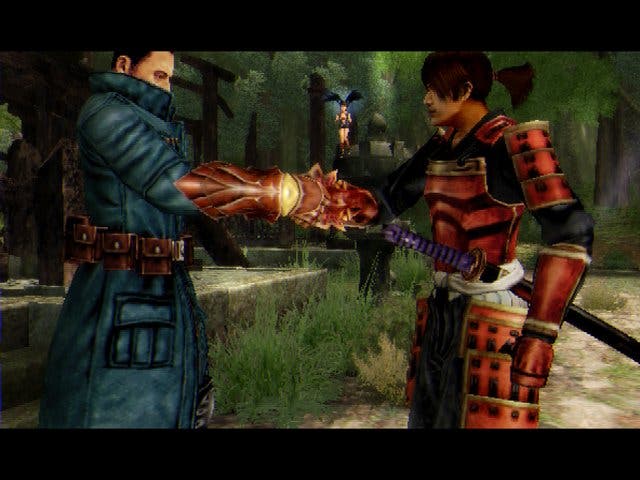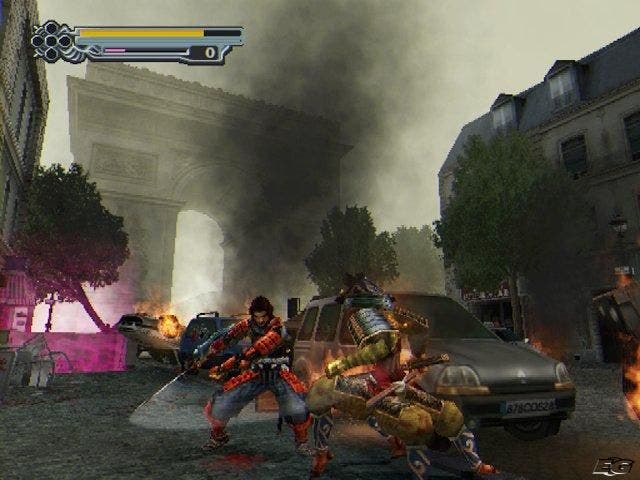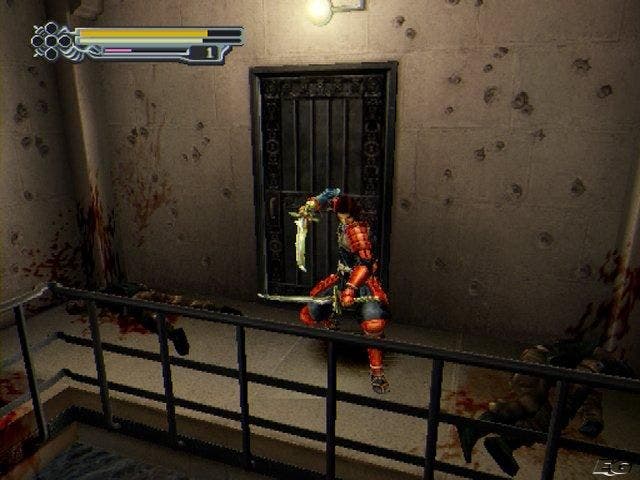Onimusha 3: Demon Siege
Find out what Jean Reno gets up to in his spare time...
When your parents come out with gems like 'the years go by so quick when you're old' it's not just because they're turning into senile doddering old cretins that rarely know what day it is anymore. It's true. In fact, it seems scarcely credible that it's nearly three years ago since Onimusha: Warlords bestrode the summit of the UK's game chart. No wonder time travel seems so appealing to the nefarious types in Capcom's latest attempt to bring feudal-era Japanese hackandslash to the masses - they're fed up with constantly being told how old they are, and want to nip back to their early 20s to recapture their glory years. Who can blame them?
In the third episode in the all-action series Capcom has taken the innovative step of enlisting the services of French movie star Jean Reno (Leon, Subway, Ronin, Mission: Impossible) to co-star as modern day cop Jacques Blanc alongside series stalwart Takeshi Kaneshiro as the ubiquitous Samanosuke Akechi - in a time-travelling battle against the evil man's evil man, Nobunaga and his seemingly endless collection of loyal minions.
Essentially the premise of Onimusha 3 (lets call it O3, shall we?) is the usual good versus evil romp - but with that old gaming fallback Time Travel allowing Capcom to bring it bang up to date while simultaneously keeping the series faithful to its 16th Century roots.
Call him Nobby for short, that'll really wind him up

Chief villain Nobunaga and his faithful sidekicks Ranmaru, Gildenstern and company have worked out a way to mess around with Time Folds, which effectively allows them to spew forth their demonic Genma hordes wherever and whenever they choose. Mwuahahahaha. Samanosuke has other ideas, naturally, and the game kicks off with the manic sword wielding action hero transported to modern day Paris, with Jacques busy gunning it out against a posse of undead samurai scum. It all goes a bit pear shaped when he finds his girlfriend Michelle injured in the melee, and then finds himself whisked off to 16th Century Japan to do battle alongside Samonosuke against a seemingly endless procession of respawning Genma evil. Accompanying them almost every step of the way is the giggling Ako, a flying pixie 'Tengu' who helps them by opening up chests and retrieving health upgrades and ammo, as well as providing curious 'vests' which help Sam and Jacques in all manner of semi-useful ways, such as recharging lost health and sucking the souls out of enemies.
The game basics work in more or less the same way as the previous two titles, albeit with some welcome tweaks and additions. As ever, you're largely involved in a series of mass brawls with enemies - who often respawn when you return to the same area on the hunt for important objects and keys. Boiled down to its bare essence, it's that same old Capcom survival horror template, where you're trotting around looking for a way to the next section while keeping a close eye on your save game management and health status. But to bracket it as a mere hackandslash version of Resident Evil would be a little unfair, however valid those comparisons are in reality.
As before, you build up a selection of gauntlets which act as both your choice of weapons and a means of collecting the 'souls' of various colour that spew forth from every defeated victim (Red for enhancing weapons/armour, blue for magic/ogre power, yellow for health, purple for the 'smart bomb' Onimusha mode). Combat is very much a priority, and the more souls you collect, the more you can upgrade your weapons and armour, the better your special attacks become and the greater chance you'll have against the many bosses you'll face along the way.
Porno for pyros

As a combat system it's beautifully designed, and works even better now that Capcom has finally woken up to the option of allowing players to use the analogue stick for movement. In conjunction with L1, R1 and the face buttons, the correct timing allows you to pull off some majestic attacks - but never more complicated than a couple of button presses, unlike some combo-obsessed games of this ilk. In O3, it's all about the timing and positioning, but the acrobatic pyrotechnic results are never less than impressive, even if you decide to settle for merely mashing the square button.
Perhaps the most obvious advancement is the use of a more flexible graphics engine, which gives you a far more dynamic view of proceedings. Camerawork is handled entirely by the game as ever, but the 3D engine makes the view not only far more cinematic as sections pan and scroll by as required, but not at the expense of the lavish pre-rendered detail of old. There are still occasions when you're forced to fight enemies off screen, but the use of R1 to lock your target generally takes care of such instances. The last quarter of the game is blighted by some serious slowdown issues, but you're talking about a minute out of a 12 hour game, so we can definitely live with that when the visual quality on show is so unflinchingly high.
It's hard to find fault with any of the visuals, in fact. The character models are outstanding throughout (okay the giant slugs are a bit throwaway), with wonderful attention to detail in every element you could care to zone in on, from the spot-on facial likeness of Jean Reno to the costume design, right down to the improbable array of manoeuvres so expertly animated. The backdrop to the proceedings is pleasantly varied throughout also, largely thanks to the game's ability to keep switching back and forth between the 16th and 21st century. Even with that in mind, it keeps throwing surprises at you (which we won't spoil for you, but we're itching to talk about), taking in an almost mind-boggling array of unlikely settings (which must number in the dozens) over the course of what is a much bigger game than previously. Variety over the previous titles is evident right from the word go.
Multiple organisms

Another facet introduced this time around, and fairly in keeping with Capcom's games down the years, is the use of multiple playable characters which switch in and out of control in keeping with the storyline. Samonosuke and Jacques take the lion's share of the game, while Jacque's abundantly breasty partner Michelle has small cameo roles towards the end of the game. Each has their own unique weapons, and this, again, helps keep the game fresh whenever it's in danger of becoming a tiresome slog against the legion of annoying respawning bastards. In its favour, though, unlike other games, the respawning enemies in O3 actually help you in the sense that the payback is upgraded weaponry, while the combat in itself feels exciting enough to rarely feel like a chore - apart from those occasions where you're just plain stuck and having to backtrack to find something you missed.
The time travel aspect also adds a neat element to the puzzle aspect of the game, with Jacques and Sam regularly forced to trade objects through time in order to get past something blocking them. We recall a similar system working extremely well in LucasArts' adventure classic Day Of The Tentacle, and it's just as ingenious here as you're forced to rack your brain to work out what effect certain objects and actions will have.
Elsewhere, O3 regularly presents optional block-moving puzzles of increasing difficulty in return for health and magic upgrades. Some will literally have you cursing for 20 minutes or more, and it's an even greater joy to discover that one of the game's unlockables is a suite of three puzzle games - each of which are more than worthy additions to a good value package.
Easy is the new Normal

In keeping with other Capcom titles, the game also offers an Easy route to success at a crucial crossroads point in the game about 20 per cent in. Although this won't help you solve the puzzles any quicker, it's a boon to not have to stress about health packs quite as much, and naturally the normally brutally hard bosses crumble relatively quickly - although nowhere near as quickly as you might expect. Suffice to say that Capcom has judged the difficulty level pretty much spot on in that adventure fans won't feel alienated by hardcore combat, while those of a masochistic bent will be guaranteed of an often brutal challenge that will last much longer than previous games in the series.
From our obvious Western bias, it's fair to say that massive compromises have been made to the original vision of the game in an attempt to appeal to our tastes. Sometimes it comes off, sometimes it seems schmaltzy, but is typical Capcom through and through with the usual posse of demented megalomaniacs cackling at your all conquering attempts. In traditional fashion, the whole game is littered with journal scraps and miscellaneous fragments for you to piece together in your own time. As ever, the more time you spend consuming these seemingly random ramblings, the more coherent the whole tale becomes. As Capcom-related stories go it hangs together better than most, but is still as trivial as ever and not exactly essential.
On the down side, there's nothing especially new or stand-out exciting about O3. As enjoyable as it undoubtedly was, it's largely a case of more of the same, albeit with a grander setting and a movie star playing a lead role. In terms of actual gameplay mechanics, very little has really changed in those three years. If anything, this is more of a back to basics return to the action-packed style of the original, with none of that pointless object swapping Shenmue-style of Mk.2, but in terms of originality or refreshing new features, you might come away undernourished.
Voicing disapproval
Given that we've reviewed the newly released NTSC version here, it's perhaps premature to criticise the voice acting, but the game kicks off with Jacques spouting his native French before quickly lapsing into a broad American accent so out of character it immediately loses credibility. Surely a French actor's voice speaking English would have been infinitely preferable to someone's voice that plainly doesn't fit the character? The others are reasonably acceptable, though, in a fairly camp operatic guffawing nefarious way. The ten year-old Henri, however, grates from the first line to the last. Kill! As for the rest of the audio, it has that typically dramatic, surging Capcom feel that appears in Resi Evil games, and for the most part clangs away in the background without really registering a response from the synapses.
Coming at this fresh, what you will find is a highly polished, mostly highly enjoyable hackandslash romp with only occasional lapses into tedious gaming by numbers same-old-same-old object hunting and respawning enemy laziness. Some of the more experienced campaigners might find it a little on the easy side, but that loosely translates as 'most people might actually have a chance of finishing it' - so that's a good thing in our book. In the context of the series, it's an excellent follow up, and would certainly be a great introduction to a compelling series if you've missed out to date, while acting as a satisfying next chapter for the fans. Xbox owners, however, might want to consider a certain Tecmo offering due out in the not too distant future...


